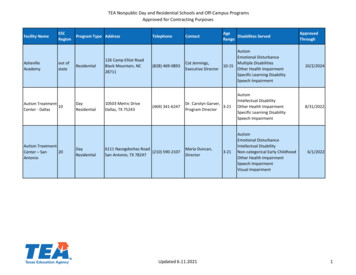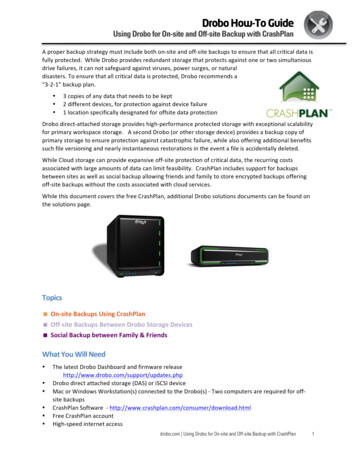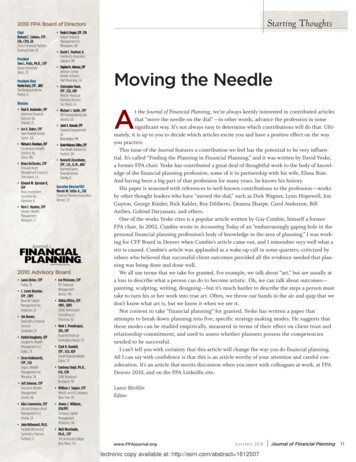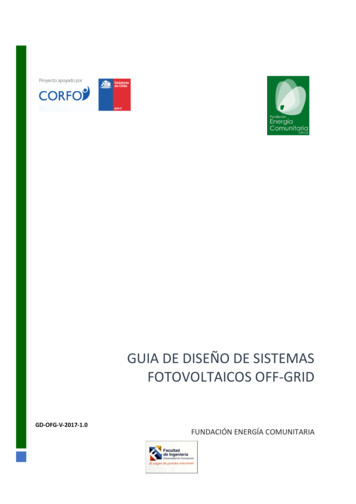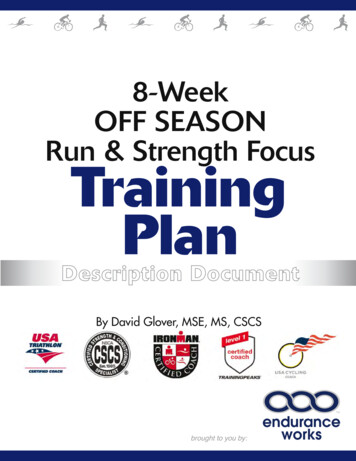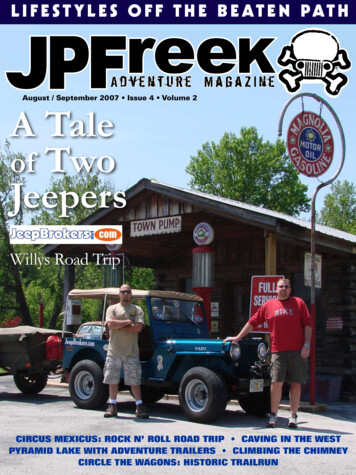
Transcription
Trade-Off Analysis Planning and Procedures GuidebookFinalViews, opinion, and/or findings contained in this report are those of the author(s) and should notbe construed as an official Department of the Army position, policy, or decision unless sodesignated by other official documentation.April 2002IWR 02-R-2
U.S. Army Institute for Water ResourcesDecision Methodologies DivisionThe U.S. Army Corps of Engineers Institute for Water Resources (IWR), is a Corps of EngineersField Operating Activity, located in Alexandria, VA. The Institute was created in 1969 to analyze andanticipate changing water resources management conditions and to develop planning methods andanalytical tools to address economic, social, institutional and environmental needs in waters resourcesplanning and policy. Since its inception, IWR has been a leader in the development of tools andstrategies for planning and executing the Corps’ water resources program.The Decision Methodologies Division supports the Corps Headquarters, Civil Works Directorateby developing evaluation methodologies, analytical models, and public involvement processes to helpplan and manage Corps water resources projects. It also supports the Research and DevelopmentDirectorate by managing one or more research programs. The division’s missions include:Investment and Management Decision Making Research ProgramNational Level Technical AssistanceNational and Special StudiesTraining and Other Technology Transfer ActivitiesField Level Technical AssistanceThe Investment and Management Decision Making Research Program includes research anddevelopment activities to improve methods to manage and conduct Corps planning studies. Researchactivities involve integration of environmental, engineering, economic and social sciences to developdecision frameworks and methods that enable the Corps to make sound decisions about water resourcesinvestments. Research outputs range from methods to facilitate stakeholder involvement in waterresources planning to mathematical models and evaluation frameworks for formulating, ecosystemrestoration and flood damage reduction projects. Research study areas include:Economic Evaluation AnalysesCost Effectiveness and Incremental CostWatershed ManagementBudget Decision MakingCollaborative Decision ProcessesIntegrated System-wide Problem SolvingPerformance MeasuresPlanning MethodologiesFor further information, call either:Kenneth D. OrthChief, Decision Methodologies Division703-428-6217Robert A. PietrowskyDirector, Institute for Water Resources703-428-8015Department of the Army, Corps of EngineersInstitute for Water Resources7701 Telegraph Road, Casey BuildingAlexandria, VA 22315-3868Many reports are available on-line at IWR s web site: www.wrc.usace.army.mil/iwr; or they may beordered at the above address; or by contacting Arlene Nurthen, IWR Publications, by fax at (703) 4288435, or by e-mail at Arlene.J.Nurthen@usace.army.mil.
Trade-Off Analysis Planning and Procedures GuidebookPrepared by:Charles Yoe, Ph.D.For:Planning and Management Consultants, Ltd.6352 South U.S. Highway 51P.O. Box 1316Carbondale, IL 62903(618) 549-2832A Report Submitted to:U.S. Army Corps of EngineersInstitute for Water ResourcesCasey Building7701 Telegraph RoadAlexandria, VA 22315-3868underTask Order #20Contract No. DACW72-00-D-0001April 2002Views, opinion, and/or findings contained in this report are those of the author(s) and should notbe construed as an official Department of the Army position, policy, or decision unless sodesignated by other official documentation.
PREFACEMaking decisions requires some form of deliberation and evaluation by the decisionmaker. When there is a single decision maker, the process may not have to be rigid or replicableor even justified to anyone other than the decision maker. In water resources planning andinvestments, there are multiple decision makers, stakeholders and other interested parties makinginputs to the decision making process. Planning for projects involving multiple and competingoutputs and stakeholders requires a collaborative effort. This process also requires a moredefinitive evaluation process, one that can be replicated and used to justify or, at a minimum,explain why specific decisions were made and who was involved in the decision making process.The proliferation of work falling into the category of National Ecosystem Restoration, (NER,i.e., providing non-monetary outputs such as Habitat Units or Acres of Wetlands) andsubsequently, the need to formulate for multiple-purpose National Economic Development,(NED, i.e., providing monetary outputs such as Flood Damage Reduction and Navigation)combined with National Ecosystem Restoration projects fostered an increased need for tools andguidance to conduct trade-off analysis and collaborative decision making. This document is a“Trade-Off Analysis Planning and Procedures Guidebook” for Corps of Engineers planningstudies.The work presented in the report was conducted as part of the Investment andManagement Decision Making Research Program, part of the Integrated Technologies forDecision Making research area. The Program is sponsored by the Headquarters, U.S. ArmyCorps of Engineers and is assigned to the Institute for Water Resources, Decision MethodologiesDivision. Mr. Darrell Nolton is Program Manager of the Investment and Management DecisionMaking Research Program. Mr. Harry Kitch, Planning Division, Mr. Jerry Foster, EngineeringDivision, and Mr. Bruce Carlson, Planning Division are the Headquarters’ Program Monitors.Field Review Group Members that provide overall Program direction include: Mr. WilliamFickel, Fort Worth District, Mr. Martin Hudson, Portland District, Mr. Matt Laws, CharlestonDistrict, Mr. Dan Sulzer, Los Angeles District, Ms. Teresa Kincade and Mr. Kenneth Barr, RockIsland District. This paper was prepared under the general supervision of Mr. Kenneth Orth,Chief of the Decision Methodologies Division, Institute for Water Resources and Mr. RobertPietrowski, Director of the Institute for Water Resources.Table of Contentsiii
ivTable of Contents
TABLE OF CONTENTSList of Figures .ixList of Tables.xiI.Introduction. 1Purpose of Manual . 2Organization of Manual . 2Summary: Take Away Points . 4Look Forward. 4II. Planning Decisions and Trade-Offs . 5The Planning Process . 5Decisions. 6Decision Hierarchy . 8The Public and Collaborative Planning . 9Trade-Offs Defined . 13Terminology. 16Summary: Take Away Points . 16Look Forward. 17III. Multicriteria Decision Framework. 19Decision Support Framework . 20The People of the Decision Support Framework. 21Component 1: Problems. 23Component 2: Alternatives . 24Component 3: Criteria . 25Component 4: Evaluation . 29Component 5: Decision Matrix. 32Construction of Matrix . 33Pre-Analysis. 34Normalization . 34Component 6: Weights . 38Fixed Point Scoring . 41Rating. 42Ordinal Ranking . 42Graphical Weighting. 43Paired Comparisons . 43Normalization of Weights . 45Summary. 45Component 7: Synthesis . 45Component 8: Decision . 46Summary: Take Away Points . 47Look Forward. 47Table of Contentsv
IV. Simple Decision Rules . 49Simple Rules for Decision Making. 49Optimization . 50Domination Procedures. 51Conjunctive Procedures . 53Disjunctive Procedures . 54Elimination by Aspects . 55Commensurable and incommensurable metrics, cardinal and ordinal data, directweights. 55Lexicographic Rules . 56Summary: Take Away Points . 57Look Forward. 57V. Case Study. 59Pre-Analysis . 59Optimization. 63Lexicographic Ordering . 63Case Study Decision Matrix . 64Normalization of Case Study . 65Summary: Take Away Points . 65Look Forward. 66VI. Popular Methods . 67Weighting Methods. 67Non-Normalized Weighted Products. 68Normalized Weighted Products . 69Effects Matrix . 71Ranking Index . 72Commensurable Metric, Ordinal Data, Direct Weights . 72Ordinal Ranking. 73Borda’s Simple Method . 74Unequal Weights. 75Multiple Attribute Utility Theory . 76Outranking Methods . 80Analytical Hierarchy Process. 83Summary: Take Away Points . 84Look Forward. 85VII. Evaluation and Trade-Offs . 87The Situation . 87Making Cost Effectiveness Trade-Offs. 89Simple Decision Rules . 89Optimization . 89Domination Procedures. 90Conjunctive Procedures . 90Disjunctive Procedures . 91Elimination by Aspects . 91Lexicographic Rules . 92viTable of Contents
Weighting Methods. 92Equal Weights. 92Unequal Weights. 93More Complex Methods . 94Cost Effectiveness Trade-Off Recommendations. 94Summary: Take Away Points . 95Look Forward. 95VIII. Multicriteria Decision Making Software Examples. 97Decision Lab 2000 . 98Input Requirements. 98Rankings . 99Analysis of Results . 101Expert Choice Pro . 104Inputs . 105Rankings . 107Analysis of Results . 109Criterium DecisionPlus . 112Inputs . 113Ranking. 114Analysis of Results . 115Commentary. 118Summary: Take Away Points . 119Look Forward. 119IX. What Makes A Good Decision Tool? . 121Qualities of a Good Technique .
Training and Other Technology Transfer Activities Field Level Technical Assistance The Investment and Management Decision Making Research Program includes research and development activities to impr
